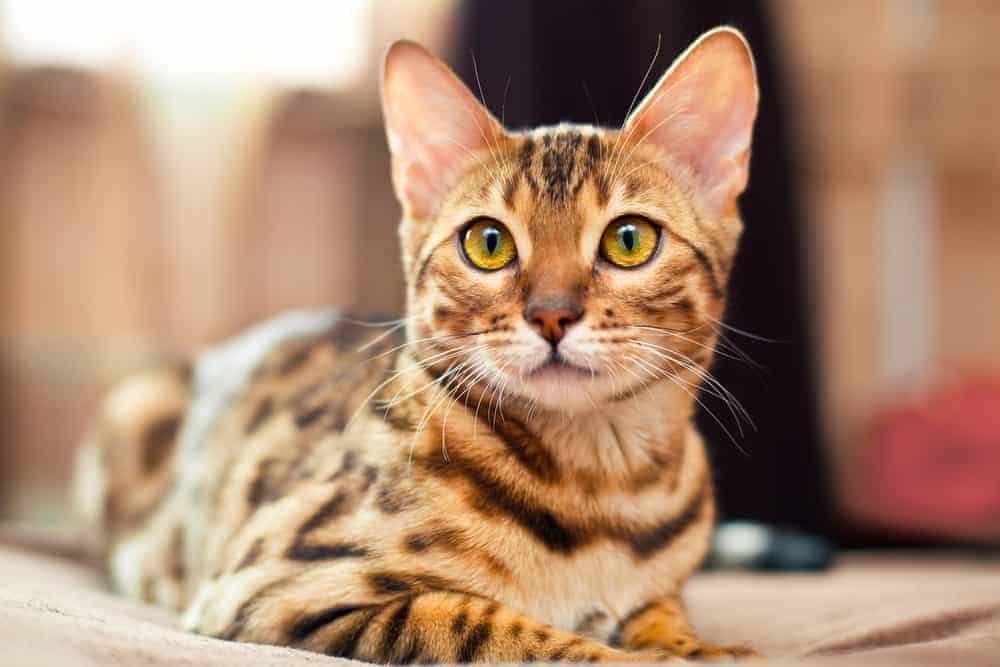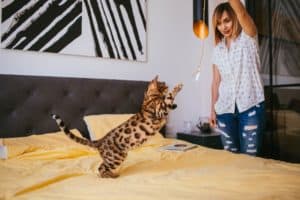
Bengal cat breed profile. Photo: Shvaygert Ekaterina/Shutterstock
Bengal cat classification
The Bengal Cat is classed as Group 3 (BEN) by the Australian Cat Federation (ACF).
Bengal cat history
Like all domestic cats, the Bengal Cat traces its origins to non-domestic ancestors. However, today’s domestic Bengal Cat comes only from breeding Bengals to other Bengals.
In the 1970s, Willard Centerwall bred Asian Leopard Cats with domestic cats to aid his studies in genetics because of their apparent immunity to feline leukaemia. Eventually, these hybrids were given to Jean Sudgen Mill because of Centerwall’s illness.
At the same time, Bill Engler wanted to preserve the exotic cats’ genes by breeding them with house cats. Although none of today’s Bengal lines originates from these cats, he chose the name “Bengal”, which was accepted by the American Cat Fanciers Association (ACFA), the first registry to accept the breed.
(There are some others hold true to the story that the name was indeed inspired by Bill Engler himself, B.Engle. but this is unlikely.)
Jean Mill was instrumental in recognition of Bengals as a breed by The International Cat Association (TICA) in 1983. Her plan was not to keep the breed as a hybrid but to domesticate these cats by breeding them further with each other.
Greg and Elizabeth Kent were also early breeders, who developed their own line of Bengals using Asian Leopard Cats and Egyptian Maus. This was a very successful line and many modern Bengals will find it in their pedigree.
Bengal cat physical characteristics
The Bengal cat is a ‘wild’ looking domestic cat. The standard calls for a large, sleek, very muscular cat with hindquarters that are slightly higher than the shoulders, and a thick tail that is carried low. The Bengal cat’s head is rounded and slightly longer than it is wide.
The nose is broad and the muzzle full, with a light coloured, strong rounded chin and pronounced whisker pads created by wide-set canine teeth. The ears are medium to small with rounded tips pointing forward in profile.
Bengal males can weigh between 6.8 to 9kg and females between 4.5 to 5.4kg.
Bengal cat personality traits
Bengal cats are said to be loyal, loving and will quickly become part of your family, mixing well with children and other animals. Some of the Bengal cat’s wild instincts have been retained, including a love of water, so owners are advised to keep toilet seats closed and expect to see their Bengal cats drinking from a tap.
Other traits include intelligence; Bengal cats are said to be adaptable and sociable, and they can often be talkative.
Note: All cats are individuals. While there is a great difference between cat breeds there is also a difference in temperament within breeds. Temperament is affected by a number of factors, including heredity, training, and socialisation.
Bengal cat care
Diet – While protein is highly essential for Bengal cats, it should only make up about 70-80% of their diet and not 100%. Minerals and vitamins should also be part of it. A raw diet is good for Bengal cats and specific foods that do them some good include fresh turkey (contains proteins and Omega 3 fats), lean cuts of fresh meat (provide protein and digestible fibre) as well as chicken. It is important to note that if not prepared correctly, raw meat can cause food poisoning. Ensure that raw meat is always fresh.
Quality commercial cat food provides an excellent alternative to a raw diet for your Bengal cat. However, don’t fall for anything because not all brands offer good cat food. To meet the dietary needs of a Bengal cat, a great balance of nutrients is of paramount importance. You want to ensure that you focus on implementing a diet that strikes the perfect balance between fresh, raw meat as well as commercial foods that contain plenty of vitamins and minerals.
Talk to a veterinarian about the nutritional requirements for a Bengal cat breed.
Grooming – Bengal cats are extremely efficient self-groomers, therefore they require little grooming. However, vets do recommend grooming once a week to limit shedding and keep their coat healthy.

Bengal cat playing. Photo: Pyrzhenka/Shutterstock
Shedding – As well as being desired for their appearance, they are also known for being a breed that sheds very little. Many claim that the Bengal cat is a hypoallergenic breed, but this is purely anecdotal evidence, and while some people may not react, others will still have an allergic reaction to them. This has to do with the dander of the cat and not the amount that it sheds.
Exercise and Games – There is a range of games that all cats should enjoy both inside and outside. Such games involve waving feather wand toys or other cat toys that require the cat to leap in the air and try to capture the flying object; hide and seek, pouncing, jumping and scrunching soft toys and paper are all worthwhile activities, remembering that cats have more energy to play at the beginning and end of each day. Play with your cat 15 minutes twice a day ideally at the same time as cats love their routine.
Here are some further ideas to entertain your cat and 10 tips to keep your cat happy.
Bengal cat health issues
Bengal cats generally have a lifespan of between 12 and 16 years.
Cat health issues in Bengals are numerous, but the average Bengal usually only possesses a few of them. Naturally, genetics play a large role in determining the potential ailments of a specific cat breed, and Bengals are no exception to this rule. If you are in any way interesting in owning a Bengal cat, you should be informed about what your Bengal cat is genetically predisposed to:
- Progressive retinal atrophy is a condition that occurs when the light receptors in the eye gradually degrade and become useless in function with blindness the outcome.
- Hypertrophic cardiomyopathy is commonly seen in Bengal cats; although, usually this condition presents at the onset of old age.
- Luxating patella, which is a condition that occurs when the kneecap does not maintain its stationary position within the knee, but rather it slips in and out of place sporadically.
- Anesthetic allergies
Talk to a veterinarian about the health issues for this cat breed.
Bengal cat suitability
This breed is extremely playful and active. Unlike other breeds that mellow with age, Bengals have a life-long, high-energy level and need interactive toys and an owner who takes time to play with them every day. These cats require a great deal of attention and affection and can become a bit mischievous without it. But when given the necessary attention and love, Bengal cats can make a wonderful companion for most types of household and will be good with children, if children have been taught to play appropriately with cats.
Always supervise interaction between a young child or other animals and your new kitten! Find out more about creating smooth introductions in our Paw Perfect Introductions podcast with renowned animal behaviourist Dr Joanne Righetti.
More details on the Bengal cat breed
Bengal cat Adoption in Australia


